

Aberdeen. Coordinates: Aberdeen i/æbərˈdiːn/ (Scots: Aiberdeen listen ; Scottish Gaelic: Obar Dheathain [ˈopər ˈʝɛhɪn]) is Scotland's third most populous city, one of Scotland's 32 local government council areas and the United Kingdom's 37th most populous built-up area, with an official population estimate of 220,420.[4]
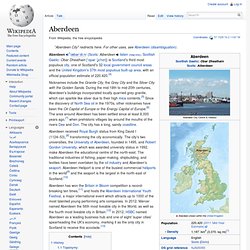
Aberdeen City Council: The official website. What's on Crystal Clay Workshop On 12 Apr 2014 Beginners jewellery class, learn how to make crystal paved jewellery.

Breakneck Comedy! A must see comedy club Simon Singh : The Simpsons and their Mathematical Secrets Simon Singh, author of Fermat's Last Theorem and Big Bang, talks about his latest book, which explores mathematical themes hidden in The Simpsons. More What's On Events... Press Releases. Official Tourism Site for Aberdeen City & Shire - homepage. Visitors > Tourist Attraction Aberdeen, Tourist Location Aberdeen, Day Out Aberdeen - Satrosphere Science Centre. Aberdeen. What's On in Aberdeen, Attractions, Accommodation, Restaurants & Conferences › VisitAberdeen. Architecture of Aberdeen. St Mark's Church, Rosemount Viaduct Marischal College The Architecture of Aberdeen is known for the use of granite as the principal construction material.
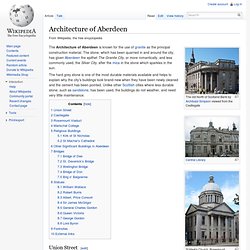
The stone, which has been quarried in and around the city, has given Aberdeen the epithet The Granite City, or more romantically, and less commonly used, the Silver City, after the mica in the stone which sparkles in the sun. The hard grey stone is one of the most durable materials available and helps to explain why the city's buildings look brand-new when they have been newly cleaned and the cement has been pointed. Unlike other Scottish cities where less durable stone, such as sandstone, has been used, the buildings do not weather, and need very little maintenance. Union Street[edit] Union Street runs for nearly a mile (1.5 km), is 70 ft (21 m) wide, and originally contained the principal shops and most of the public buildings, all of granite.
Aberdeen Castle. Aberdeen Castle was a late Middle Ages fortification,[1] in Aberdeen, Scotland.[2] It was situated on Castle Hill, a site today known as the Castlegate, where a block of flats is currently located.[3] It is thought the castle and fortifications were burned down[4] by King Robert the Bruce in June 1308, during the Wars of Scottish Independence immediately following the Harrying of Buchan.
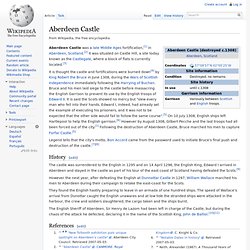
Bruce and his men laid siege to the castle before massacring the English Garrison to prevent its use by the English troops of Edward II. It is said the Scots showed no mercy but "slew every man who fell into their hands. History[edit] Statues Around Aberdeen. - Aberdeen Voice. By Dave Watt. 1) King Edward VII – corner of Union Terrace/Union St by Alfred Drury RA & James Philip.
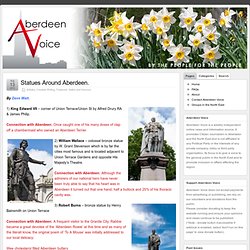
Connection with Aberdeen: Once caught one of his many doses of clap off a chambermaid who owned an Aberdeen Terrier. 2) William Wallace – colossal bronze statue by W. Grant Stevenson which is by far the cities most famous and is located adjacent to Union Terrace Gardens and opposite His Majesty’s Theatre. Connection with Aberdeen: Although the admirers of our national hero have never been truly able to say that his heart was in Aberdeen it turned out that one hand, half a buttock and 25% of his thoracic cavity was. 3) Robert Burns – bronze statue by Henry Bainsmith on Union Terrace. Robert Burns - Aberdeen Voice. We continue our serialisation of David Innes’ interview with author Maggie Craig.

Her two books on the Jacobite Rebellion, the evocatively-titled ‘Damn’ Rebel Bitches: The Women of the ‘45’, and ‘Bare-Arsed Banditti: The Men of the ‘45’ are critically-lauded. She explains why she looks at that fractious period of our heritage from a different angle to that usually taken by historians. You’ve written two books on the Jacobites – where did that inspiration come from? That came from a novel called The Flight of the Heron by DK Broster which an uncle gave to me.
Rubislaw quarry. View overlooking the quarry Rubislaw Quarry was opened in 1740 and is located at the Hill of Rubislaw in the west end of the Scottish city of Aberdeen .
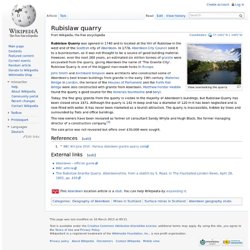
In 1778, Aberdeen City Council sold it to a businessman, as it was not thought to be a source of good building material. Legacies - Architectural Heritage - Scotland - North-East Scotland - How Granite Made a City - Article Page 1. Famous Aberdeen granite quarry sold. Aberdeen's iconic Rubislaw Quarry has been acquired by two local businessmen, BBC Scotland can reveal.
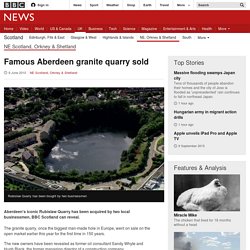
The granite quarry, once the biggest man-made hole in Europe, went on sale on the open market earlier this year for the first time in 150 years. The new owners have been revealed as former oil consultant Sandy Whyte and Hugh Black, the former managing director of a construction company. The sale price was not revealed but offers over £30,000 were sought. Scotlnd-rubislaw_gran_qurry_aberdeenshire_1862_1.jpg (JPEG Image, 762 × 550 pixels) Union Bridge, Aberdeen. Union Bridge is a bridge on Union Street, Aberdeen, Scotland.
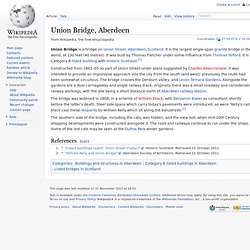
It is the largest single-span granite bridge in the world, at 130 feet (40 metres). It was built by Thomas Fletcher under some influence from Thomas Telford. It is a Category B listed building with Historic Scotland.[1] Constructed from 1801–05 as part of Union Street under plans suggested by Charles Abercrombie, it was intended to provide an impressive approach into the city from the south (and west); previously the route had been somewhat circuitous. Listed Building Report. Aberdeen, Union Street, Union Bridge. You may copy, display, store and make derivative works for personal use or use solely within an educational institution by staff and students, under these conditions: the ScotlandsPlaces website is attributed, there is no commercial use or sale, and no public distribution (for example, by hand, email, or web).
Full licence details . View of Union Terrace, Aberdeen, with a tram including statue of King Edward VII. A Brown and Company Date 1930 Copyright RCAHMS Organisation. The University of Aberdeen. Aberdeen College Further Education Courses. Aberdeen's Robert Gordon University (RGU) Home. Press And Journal. List of Aberdonians. There are many notable Aberdonians from Aberdeen and Aberdeenshire in Scotland.

In modern times the British Open winning golfer Paul Lawrie and the musician Annie Lennox are the most famous names. However in the past Aberdeen has produced many important people such as Thomas Blake Glover, the founder of Mitsubishi, and Bertie Charles Forbes who founded the Forbes publishing empire. Architects and designers[edit] Bill Gibb (1943-1988), fashion designerJames Gibbs (1682–1754), architectArchibald Simpson (1790–1847), architect (responsible for many Aberdeen buildings) Artists and sculptors[edit] Authors, journalists and writers[edit] Musicians[edit] Politicians[edit] Religion[edit] Science and medicine[edit]
John Barbour. George Jameson. Mary Slessor. Annie Lennox. Aberdeen Harbour - a world class port. Aberdeen Built Ships. Aberdeenshire Canal. History[edit] Aberdeenshire Canal. Doric dialect (Scotland) Doric, the popular name for Mid Northern Scots[1] or Northeast Scots,[2] refers to the dialects of Scots spoken in the northeast of Scotland. There is an extensive body of literature, mostly poetry, ballads, and songs. The term "Doric" was used to refer to all dialects of Lowland Scots but during the twentieth century it became increasingly associated with Mid Northern Scots.[3] Quines and Loons.